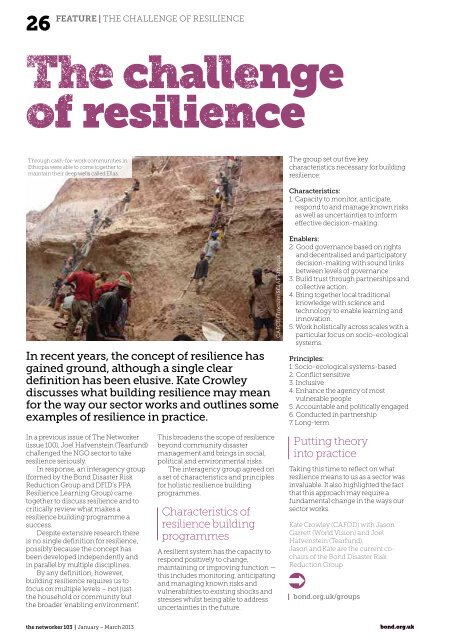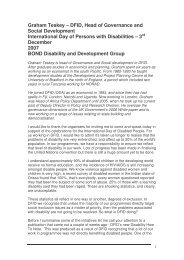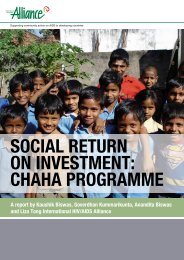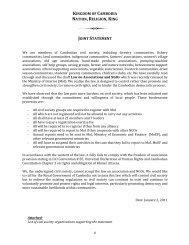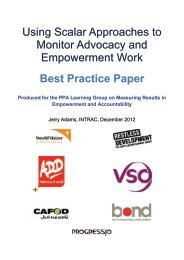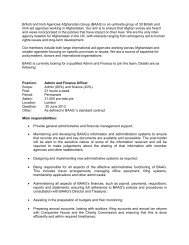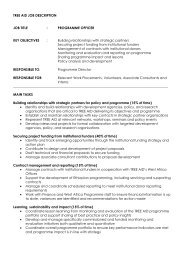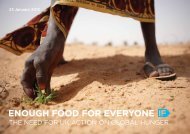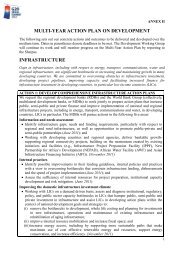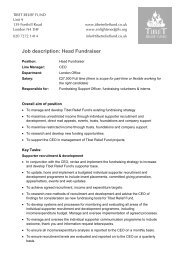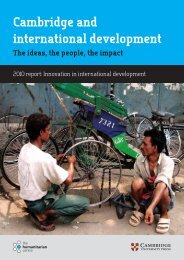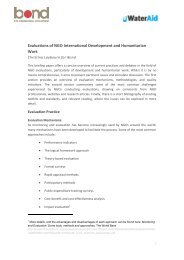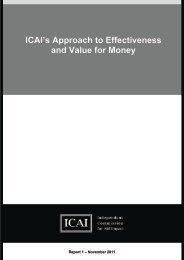Here - Bond
Here - Bond
Here - Bond
- No tags were found...
Create successful ePaper yourself
Turn your PDF publications into a flip-book with our unique Google optimized e-Paper software.
Feature | The challenge of resilience26 27The challengeof resilienceThrough cash-for-work communities inEthiopia were able to come together tomaintain their deep wells called Ellas.In recent years, the concept of resilience hasgained ground, although a single cleardefinition has been elusive. Kate Crowleydiscusses what building resilience may meanfor the way our sector works and outlines someexamples of resilience in practice.In a previous issue of The Networker(issue 100), Joel Hafvenstein (Tearfund)challenged the NGO sector to takeresilience seriously.In response, an interagency group(formed by the <strong>Bond</strong> Disaster RiskReduction Group and DFID’s PPAResilience Learning Group) cametogether to discuss resilience and tocritically review what makes aresilience building programme asuccess.Despite extensive research thereis no single definition for resilience,possibly because the concept hasbeen developed independently andin parallel by multiple disciplines.By any definition, however,building resilience requires us tofocus on multiple levels – not justthe household or community butthe broader ‘enabling environment’.This broadens the scope of resiliencebeyond community disastermanagement and brings in social,political and environmental risks.The interagency group agreed ona set of characteristics and principlesfor holistic resilience buildingprogrammes.Characteristics ofresilience buildingprogrammesA resilient system has the capacity torespond positively to change,maintaining or improving function —this includes monitoring, anticipatingand managing known risks andvulnerabilities to existing shocks andstresses whilst being able to addressuncertainties in the future.CAFOD/Trócaire/SCIAF EthiopiaThe group set out five keycharacteristics necessary for buildingresilience:Characteristics:1. Capacity to monitor, anticipate,respond to and manage known risksas well as uncertainties to informeffective decision-making.Enablers:2. Good governance based on rightsand decentralised and participatorydecision-making with sound linksbetween levels of governance.3. Build trust through partnerships andcollective action.4. Bring together local traditionalknowledge with science andtechnology to enable learning andinnovation.5. Work holistically across scales with aparticular focus on socio-ecologicalsystems.Principles:1. Socio-ecological systems-based2. Conflict sensitive3. Inclusive4. Enhance the agency of mostvulnerable people5. Accountable and politically engaged6. Conducted in partnership7. Long-termPutting theoryinto practiceTaking this time to reflect on whatresilience means to us as a sector wasinvaluable. It also highlighted the factthat this approach may require afundamental change in the ways oursector works.Kate Crowley (CAFOD) with JasonGarrett (World Vision) and JoelHafvenstein (Tearfund).Jason and Kate are the current cochairsof the <strong>Bond</strong> Disaster RiskReduction Group.bond.org.uk/groups12Resilience ofrural livelihoodsin EthiopiaMechu Dayo, aged 40, a mother of11 children living in Tisho Kebeleof Burji, is one of the beneficiariesof the resilience project.Resilience indisasters inMozambiqueCAFOD Trócaire SCIAF EthiopiaJessica Matthews, CAFODCAFOD is working in Mozambique with CaritasMaputo to improve the lives of people livingwith HIV & AIDS; providing home-based carealongside group-based agricultural support sothat people like Tinhico Salvador Chavangocan grow food to feed her family and share withthe wider community. Together with work onHIV prevention, this contributes to an holisticapproach, reflecting the underlying ethos ofresilience building.Pastoralist communities in Ethiopiaare particularly vulnerable to foodinsecurity due to environmentalfactors, value chain and marketlimitations, price fluctuations anda policy environment that oftenneglects the specific needs andpotential contribution of pastoralistcommunities.Building resilient pastoralistcommunities in Borana is a large EUfunded programme, (implementedby the CAFOD/SCIAF/Trócaire JointEthiopia Programme (CST) inconsortium with AFD, ACORD, CIFA,GPDI, SOS Sahel, Cordaid and ILRI) ineight woredas (districts) of the BoranaZone, Oromia Region in the south ofEthiopia. It combined rangelandmanagement, water resource accessand livelihood diversification inaddition to encouraging collectiveaction and learning at all stakeholderscales.To ensure sustainability, thisprogramme encouraged stakeholdernetworking and monitoring. NGOpartners, traditional local leaders andgovernments all worked together withthe community to design and reviewthe programme through meetings atdistrict and zone level.Specific project highlights includeIn 2005, World Vision Mozambiqueresponded to the impacts of repeateddisaster events across the country bydeveloping a new approach tocommunity based disaster riskmanagement. They called the processGERANDO – Gestão de Risco a Nívelda Comunidade (Community BasedRisk Reduction).Through GERANDO acommunity-led structure encouragedcollective participation and actionwhich enabled the identification ofways to respond to and manage therange of risks associated within theirsocial and environmental context.As a community-owned processthese activities naturally incorporatedlocal indigenous knowledge into theirrisk management plans, restoring thecultural transmission of knowledgebetween generations that had beenlost through civil war, labourmigration and HIV/AIDS over the past30 years.using a combination of technical andlocal expertise to identify and protectnative and useful bush species whilstcommunities were trained inalternative selective bush clearancetechniques. All cleared areas are nowreserved as communal grazingreserves or kallos that are used as dryseason and/or emergency grazingareas for the warra stock/small stockand pregnant and lactating animals.This combination of local andexternal knowledge and an ability toadjust traditional practices enabledcattle to graze whilst protectingmarketable plants such as aloe-vera.Diversifying incomes enabled thecommunity members, in particularwomen, to start saving therebypreparing for times of hardship.Training community members wasa key element to this programme.The programme establishedSACCOs: saving and creditcooperatives where the group isprovided with seed funds and theystart a cycle of giving credit andadvice to members. This enabledindividuals to start their own differentbusinesses.Cash-for-work enabledcommunities to re-habilitate theirwells and ponds.One community was alreadyrunning a World Vision AccumulatedSavings and Credit Associations(ASCA) project. GERANDO helped tofocus the investment of ASCA fundson resilience-building, disastermitigation and prevention activities,as well as providing specific targetedsupport through the ‘social fund’ toparticularly vulnerable households.The funds have helped families tobuild more structurally secure homes,buy oxen for breeding and incomegeneration, and pay for schoolequipment and fees ensuring theirchildren could remain in education.These programmes arecommunity focussed, participatoryand integrated. The challenge now isto make sure that we take the lessonsfrom these programmes to strengthenour understanding of resilience interms of measurement and impact.Building resilience requires us tofocus on multiple levels – not justthe household or community butthe broader ‘enabling environment’the networker 103 | January – March 2013 bond.org.ukbond.org.ukthe the networker 102103 | October–December | January – March 2012 2013


